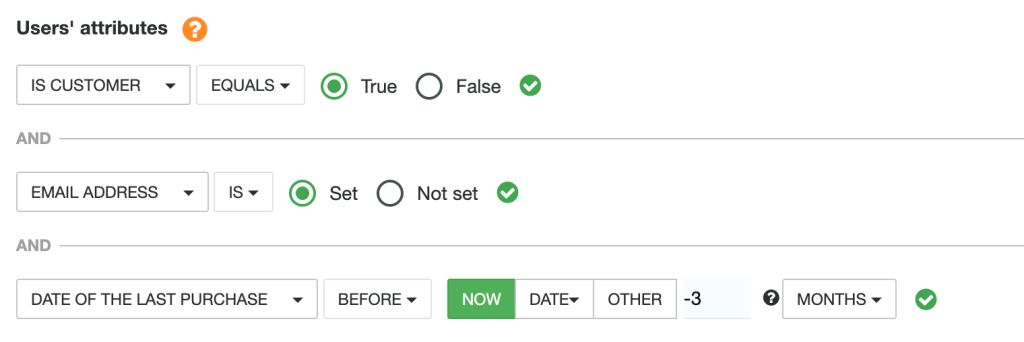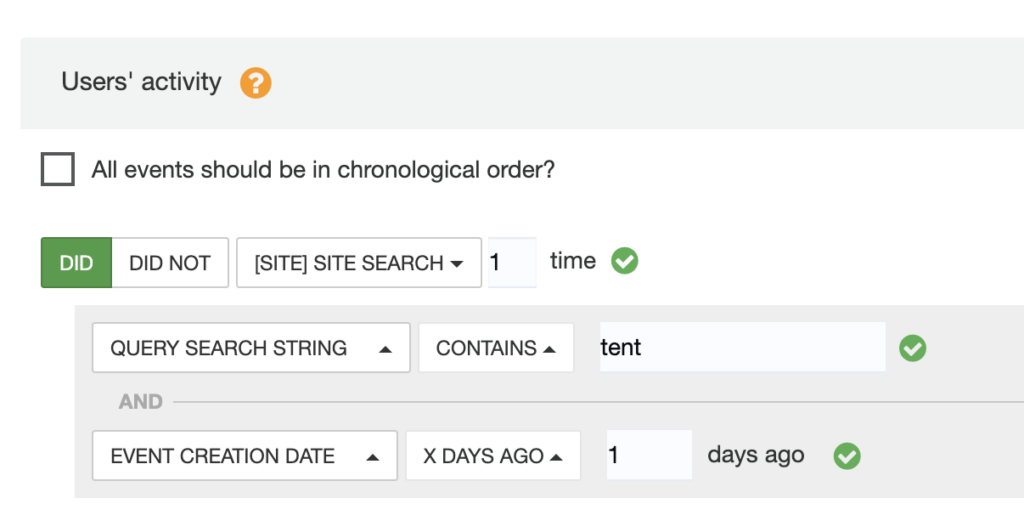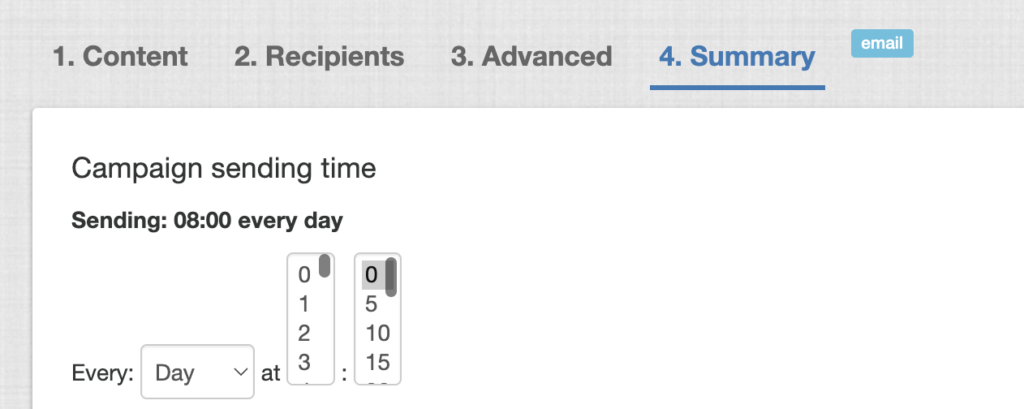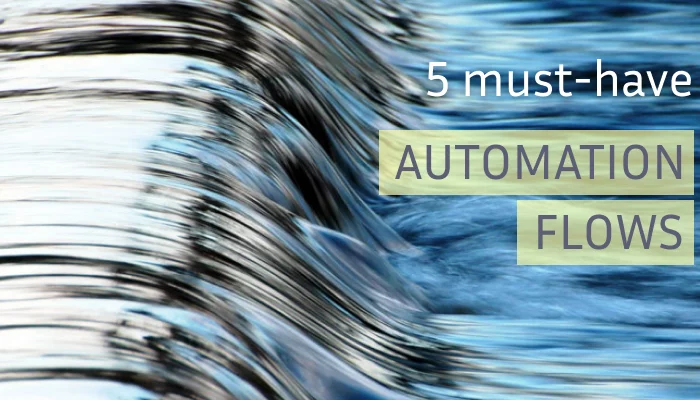Did you notice that we didn’t specify email? Because Vibetrace it’s a cross-channel communication platform, which means that you can connect to your customers through:
- email marketing (still the best retargeting channel)
- SMS marketing
- web push notifications
- onsite personalization
So what is Automation Flow?
An automation flow is one or more actions that take place based on some initial trigger. This trigger can be:
- a user activity or event
- result of a dynamic segment, most of the times in relation to a date
- an update of user data
From a technical perspective, an ecommerce business is easier to track compared to some other (custom) online businesses. Because activity on an ecommerce store is more or less the same every time:
Visit website > Browse categories & products > Add to cart > Checkout > Order confirmation
But what happens when this flow does not happen up to the end? If your conversion rate is 2-3%, it means that in 97-98% of cases, this flow stops at some point.
Do you like this article?
Join our CX for Retail dedicated newsletter!

Stay connected to what’s really important to optimize your digital revenues.
By clicking the button, you accept our Terms & Conditions. Also you will need to confirm your email address.
What data is being collection?
Based on the above information, on an ecommerce store you could have the following events being track using an analytics solution. Google does it for some time, and presents the typical ecommerce implementation measure with the following actions:
- Select an item from a list
- View item details
- Add/remove a product from a shopping cart
- Initiate the checkout process
- Make purchases or refunds
- Apply promotions
Because our Customer Data Platform and Recommender Engine needs more information, we do track the following actions:
- View item
- View list of items (category page)
- Apply a search on the website
- Add product to shopping cart
- Add product to the wishlist
- Initiate checkout process (including steps)
- Make purchase
This information allows us to power the customer data platform that we provide, the inputs for our recommender engine, triggers for automation workflows and ecommerce reports.
How are automation workflows running?
Automation workflows are powered by the events and user actions. You can also use stop triggers, meaning that the workflow will stop running when user does a specific action.

We won’t go into too many details on how these things work, as we need to focus on the must have Automation Workflows for Ecommerce.
What are the must-have automation workflows?
As we have experience running over 20.000 campaigns (mostly emails), we came up with the best one that bring the most results for our customers. As we said in the beginning, those are cross-channel: email, SMS and webpush notifications.
It’s fair to recognize that email is still the best performing, bringing the most revenues.
1 Welcome messages
Keeping a customer on the long term is much easier than acquiring a new one. Same with subscribers. If a visitor of your website gave you their contact information, you just don’t stop there. It means they want to hear from you.
Contact information can be:
- email address (using an email collector, embedded form or from the checkout)
- phone number (collected from old customers, or through one of our interactive campaigns)
- webpush token (given by accepting webpush notifications from your domain)
When someone signs up to your newsletter, or accepts email communications, then your business is top of their mind. This is the best time to start engaging with them through a nurturing welcome series.
There are many possibilities here and goals you can focus on: collect more information about them (think segmentation later), identify strong potential leads, or just to lead them through the sales funnel later on.
What should the welcome messages include:
- thank them for becoming your subscriber.
- simple welcome message, describing your company, your values and what should they expect from your emails
- include a discount/voucher code if your business can do it
- remind them they can always unsubscribe
2 Cart Recovery emails
Cart recovery emails, SMS and webpush are very effective, on all levels! Customer is very close to purchase, therefore this is a very good place to retarget with a personal message.
What you can do in cart recovery emails:
- remind them what products were added to the shopping cart (embed recommender engine results)
- add a discount (this is debatable and not always recommended)
- ask what made them abandon the cart and collect the information to improve business
3 Browse Abandonment
This is most of the times top of the funnel for your visitors. People spend time on ecommerce websites without having a goal of purchasing at that moment. They might want to take a break from work, to see what’s new or just to plan a future purchase when they will be ready. (or they will have money).
Still considering those, browse abandonment can bring you really nice revenues without too much effort.
Things to consider when running browse abandonment series:
- include visited products
- try to detect gender and personalize the message and communications
- wait more time and send the message multiple times. Best times is one day 3 days and 5 days after the browse. If they do not return you can stop.
4 Order follow-ups
If you thing that it’s over after they purchased and paid for it you’re wrong. Order follow-ups can bring more revenue and create a strong connection with your customers.
There are many things you can do after a purchase. First of all and most important is the order confirmation order and a thank you message. After this one you can do:
- cross-sell: if you don’t have cross-sell added to shopping cart or add to cart event, the last possibility is after they made the purchase
- upsell: depending on some products, you can try selling more expensive items. We do not recommend less expensive or things with discounts because you might end-up with more returns
- surveys: collecting more information from your customers is never too late nor enough. Ask them what they liked about your business, or what you can improve.
5 Reactivation & Re-engagement
I bet you have old customers who only bought from you once. And then never returned. Do you have this metric?
Also, what about your email subscribers. It’s there in your list and you’re happy to have them collected. But do they ever open or click your emails? You need to re-engage and reactivate them or you’ll loose them forever.
So how you do this? With a solution like our, you can easily segment users who last opened or clicked an email 3 months ago. Same about last purchase date. Do such a segment and send them a message they can not refuze.

Things that work well with this series:
- discounts. Yes, discounts are powerful for the re-engagement series
- new items, best sellers. Powered by a strong recommendation engine, you can add this type of content to your message.
6 Search Abandonment
Another one very important related to visitors who used search and filters on your website. Statistically, a visitor who uses search features from your ecommerce store will convert 1.6x compared to one that did not.
You can also create such report to see on your website what visitors are converting more.
To create a search abandonment flow you can follow these steps:

This will select users who did a search on the website in the past X days (in this example yesterday). Now best on this segment you will need to:
- set the campaign to run every day

- create email content with product recommendations that use the Search Related algorithm. This is the minimum thing you need to do for a product recommendations block.

What’s do you think about those Automations Flows? If you can’t do those, you can try now our solution by registering a new account.
While there are many other automation workflows that you can build, those ones are the most common we’ve seen across our customer accounts.
What about your digital store? What do you think are the best automation workflows?
Let us know.

